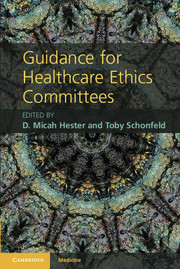Book contents
- Frontmatter
- Contents
- Contributors
- Preface
- Section 1 The Context of Healthcare Ethics Committee Work
- Section 2 Consultation
- 5 Mission, vision, goals: defining the parameters of ethics consultation
- 6 Ethics consultation process
- 7 Informed consent, shared decision-making, and the ethics committee
- 8 Decision-making capacity
- 9 Family dynamics and surrogate decision-making
- 10 Confidentiality
- 11 Advance care planning and end-of-life decision-making
- 12 Medical futility
- 13 Ethical issues in reproduction
- 14 Ethical issues in neonatology
- 15 Ethical issues in pediatrics
- Section 3 Policy Development and Organizational Issues
- Section 4 Educating Others
- Index
- References
7 - Informed consent, shared decision-making, and the ethics committee
Published online by Cambridge University Press: 05 August 2012
- Frontmatter
- Contents
- Contributors
- Preface
- Section 1 The Context of Healthcare Ethics Committee Work
- Section 2 Consultation
- 5 Mission, vision, goals: defining the parameters of ethics consultation
- 6 Ethics consultation process
- 7 Informed consent, shared decision-making, and the ethics committee
- 8 Decision-making capacity
- 9 Family dynamics and surrogate decision-making
- 10 Confidentiality
- 11 Advance care planning and end-of-life decision-making
- 12 Medical futility
- 13 Ethical issues in reproduction
- 14 Ethical issues in neonatology
- 15 Ethical issues in pediatrics
- Section 3 Policy Development and Organizational Issues
- Section 4 Educating Others
- Index
- References
Summary
Objectives
Ater reading this chapter, HEC members should be able to:
Define informed consent and shared decision-making.
Distinguish between ethical and legal requirements for informed consent.
Apply the concept of shared decision-making to a variety of cases involving autonomy, professional authority, and disclosure.
Case 1
A woman is admitted to a teaching hospital in active labor. After some hours in unproductive labor, her physician decides that oxytocin is needed to aid the labor and delivery. The physician tells the charge nurse that someone must “consent” the patient before the oxytocin is administered. The nurse approaches the patient with a consent form and a dose of oxytocin. The patient hesitates to sign, saying she does not wish to waive her right to sue the doctors and hospital in case something is done incorrectly and the baby or mother is harmed. The nurse tells the patient that, if she does not sign the consent form, she cannot deliver her baby in the hospital.
Case 2
After a teenager suggests suicide may be his best option, his parents take him to amental health hospital and, after an intake interview, the teen is admitted for in-patient treatment. The next day, the parents are called and told their son has met the doctor and been diagnosed with bipolar disorder. The parents go to the hospital in the evening and, upon arrival, are presented with a consent form. The nurse says, “If you want your son treated, sign this.” The treatment plan on the informed consent form consists of one word, “Prozac,” which is not labeled for use as a sole treatment for bipolar disorder. When the parents ask for an explanation of the treatment and diagnosis, they are told that only the doctor can give a full explanation. When the parents ask to speak to the doctor, they are told he is not available. Instead, the parents are directed to a meeting with a caseworker with no direct knowledge of the patient who describes the diagnostic criteria for bipolar disorder. The information presented is somewhat arcane to parents fearing for their son’s well-being, but it is not incomprehensible. When the parents ask which of the criteria their son meets, they cannot get an answer, of course, because the caseworker is unfamiliar with his symptoms and history. After repeated requests for more information and repeated denials, the parents withdraw their son from the facility against medical advice and are told they are risking their son’s life.
- Type
- Chapter
- Information
- Guidance for Healthcare Ethics Committees , pp. 48 - 54Publisher: Cambridge University PressPrint publication year: 2012

